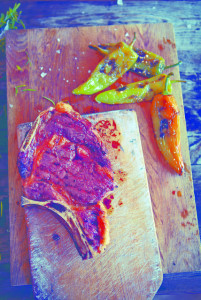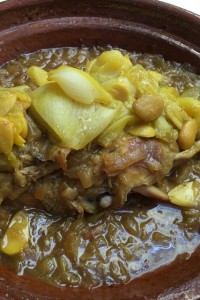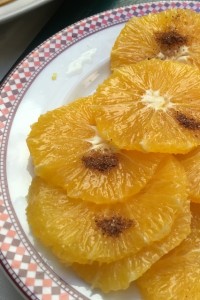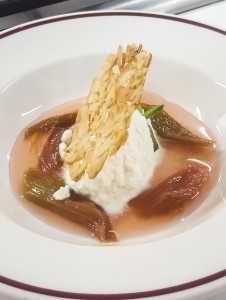Scoring a couple of nights in Inis Meáin Suites is as good as winning the Lotto as far as I’m concerned.  The rooms book out almost a year ahead and many of the guests are devoted ‘returnees’ so when the bookings open in September you need to be on your mark and ready to secure a booking. Ruairà and Marie-Thérèse de Blacam opened the restaurant in 2007 and suites were completed in 2011.
There are just five, simple and sophisticated each overlooking the dramatic landscape, a patchwork tiny fields surrounded by centuries old stone walls, each its own ancient Gaelic name and many that have never been turned in living memory. This is an Irish speaking community. Inis Meáin, Irish is rich and lyrical, it comes as quite a surprise to hear people speak in broken English just 45 minutes from the mainland.
We were met off the Ros a Mhil ferry by RuairÃ, in the cool Inis Meáin ‘mobile’. Somehow we had managed to coincide with the first day of summer. The island was teaming with wild flowers. All along the roadside, there were alexanders, violets, stitchworth.  Between the rocks in the fields, yellow birds foot trefoil, purple cranes bill, pale pink thrift, primroses, orchids, daisies, dandelions and a sea of buttercups and deep blue gentians were peeping up between the crevices in the rocky fields and little meadows. Island cattle, a few sheep and an occasional horse and donkey graze here and there and amble through the narrow gaps in walls, bearna in Irish which are filled with stones to secure the field in the time honoured way.
The air is filled with birdsong and I hear the first cuckoo of the year in the second week of May, is this a record?
The bedrooms are minimally furnished, no frills or flounces just beautiful bed linen and towels and fine toiletries. The cupboards are intelligently equipped with everything you may need, the fridge has several bottles of good wine and apple juice, Dingle gin, Writers Tears whiskey, a bottle of fizz, a packet of fine salami, Oritz tuna, a bar of Bean and Goose artisan chocolate, a couple of Brú craft beer. There are deck chairs and bikes in the porch, an umbrella should it rain, a fishing rod already baited, a torch and several beautiful books on island life.
A totally delicious breakfast arrives into the porch of your suite in a teak box at 7.30am.  You can jump out of bed to watch the dawn or snooze until noon. The insulated Pandora’s box will keep the contents in perfect condition.
The freshly laid eggs will keep warm within their hand knitted Aran cosies. On the first morning, little WECK glass jars, full of diced gravlax, pork rillettes (from their own pigs), granola, natural yoghurt, a little compartment of white and brown soda and a couple of slices of a delicious light fruit cake, chunks of ripe melon, blueberries and fresh mint leaves from the herb garden,  a pot of rich unctuous chocolate. Can you imagine tucking into that breakfast with a fine pot of strong tea or freshly ground coffee. On the second day a whole new choice….
Inis Meáin is the quietest of the three Aran Islands, sandwiched between Inis Mór and Inis OÃrr.
Its tranquillity is its charm no ‘hurdie gurdies’ or disco music, no burger and chips here. Hop on a bike and feel the wind in your hair or ramble through the little boreens with your lunch in the back pack which has been thoughtfully delivered at 10.30 of thick lentil soup and focaccia. Feel the pressure of everyday life slip away.
Ruairà de Blacam cooks the kind of food I love to eat, beautiful simple fresh ingredients straight from their little garden and tunnel. Fresh fish and shellfish from the sea, cooked from scratch, no faffing around with foams or gels or skid marks on the plate, just pure fresh flavours, simply cooked. The restaurant looks out towards the Atlantic – the Twelve Pins of Connemara silhouetted in the distance as the sun sets in the West.
A classic carpaccio from dry aged beef and a crab salad with slivers of radish from the garden and wild island flowers were particularly memorable as was a salad of thinly sliced new seasons red and golden beetroot with crème fraîche, finely chopped chives, wild garlic and herb robert flowers, drizzled with extra virgin olive oil.
Monkfish with ras en hanout and fennel and orange salad – very good with a bottle of unfiltered dry white wine from Georgia called Pheasants Tears.
It was two years since I’d been to Inis Meáin Suites, Marie-Thérèse and Ruairà have continued to reinvest in their business. Their eggs come from their own hens, the pork from their pigs, wild flowers from the island, flutter over the occasional dish. I particularly remember a hay smoked custard with new season rhubarb covered with primroses that were picked by Ruairà just minutes earlier – where would you get it?
Inis Meáin Suites is the sort of gem that one dreams about discovering but so rarely does.
So even if Ruairà and Marie-Thérèse and Inis Meáin Suites are booked out until the end of the 2016 season, it’s really worth going on a cancellation list which is how I secured my booking this time and if you can’t get into the Suites, there are several other B & B’s on the island and one can book dinner in the Inis Meáin Restaurant.
There are several ferries a day from either Doolin or Ros a Mhil. Aer Arann flies from Connemara Airport, just €49, worth every penny and they need our support. www.aerarannislands.ie
Â
Inis Meáin Hay Smoked Custard and New Season’s Rhubarb
Serves 6
For the custard
Handful of clean hay
250ml cream
4 egg yolks
20g caster sugar
For the rhubarb (enough for 12)
1 kg forced rhubarb
Zest of 2 oranges
2 split vanilla pods
100g sugar
100ml water
Firstly toast off your hay in a hot oven for 1-2 minutes to enhance the flavours.
Put the hot hay in a bowl and pour the cream over it. Cover the bowl with cling wrap and leave to infuse for a minimum of 6 hours. When this time has elapsed, pass the liquid through a fine sieve making sure to squeeze as much cream out of the hay as you can.
Discard the hay. You should have about 220ml of cream. Heat this in a saucepan until it almost starts to boil but not quite.
While the cream is heating whisk the sugar and egg yolks in a bowl until smooth. Slowly pour all the hot cream over the egg mixture, whisking constantly. Return the mixture to the saucepan and cook it out over a very low heat continuously stirring with a wooden spoon. When the custard coats the back of the spoon you’re done.
Make a syrup with the water, sugar vanilla and orange zest in a large pot. Clean and cut the rhubarb into one inch dice. Add this to the syrup and cook it out for 4-5 minutes. There should be a little bite left in the rhubarb and I must add that only forced rhubarb will do.
To finish the dish cover the bottom of each bowl with custard. Spoon some of the rhubarb into it and garnish with mint and primroses….
Inis Meáin Carpaccio of Beef
Serves 6
This the simplest recipe ever.
1kg of prime sirloin(meticulously trimmed)
For the mayonnaise
2 egg yolks
3 teaspoons of strong Dijon mustard
Juice of half a lemon
200 ml sunflower oil
Drop of milk
Salt and ground white pepper
1 plastic bottle
Ask your butcher to cut a piece of sirloin approximately 20cm long. Trim off all the fat and cut in half lengthways with the grain. Wrap in cling film, roll into two sausages, tie the ends and freeze for 1.5 hours. This makes it easier to slice it as thinly as possible.
While your beef is in the freezer make your mayonnaise. Whisk your egg yolks and mustard together adding the oil gradually to make an emulsion. When all the oil is added thin it out the dressing with the lemon juice and milk. Season. The idea is that it will end up as white as possible and runny enough to squeeze from a bottle in a crosshatch pattern. (I normally hate squeezy bottles but this is the original Harry’s Bar recipe so I’ll make an exception!)
Remove the beef from the freezer and with a very sharp knife cut against the grain in very thin slices. Cover 6 plates with the thinly sliced beef. (If you have any beef left over you can grill it for your breakfast the following day). Zig zag the dressing over the meat and serve with some toasted sourdough.
Inis Meáin Carpaccio of Mackerel with Ginger and Sesame Dressing
Make a note of this recipe to fish out when the first fresh mackerel are available – this is another example of Ruairà de Blacam’s superb, pure and simple dishes. This dressing makes a lot and keeps well. It is also delicious with noodles or pan-grilled fish. It is only worth doing this dish if the mackerel is super fresh, less than 5 hours out of the sea.
Super fresh mackerel filleted – 1 mackerel serves 2 as a starter
Â
Ginger Sesame Dressing
1250ml (2 pints/5 cups) sesame oil
1250ml (2 pints/5 cups) sunflower oil
300ml (10fl oz/1 1/4 cups) soya sauce
150g (5oz) garlic, microplaned
200g (7oz) ginger, microplaned
250g (9oz) sesame seeds toasted
Optional
spring onions, thinly sliced at an angle
coriander leaves
Fillet the spanking fresh mackerel and remove all the bones. Slice each fillet into 1/8 inch thick slices, arrange in a circle on a chilled plate. Spoon a little dressing over each portion. Sprinkle with thinly sliced spring onions and coriander seeds.
A little bowl of Periwinkles can be found all along the coast of Ireland yet we rarely find them on restaurant menus. Down on Shanagarry strand, when the tide is out and we turn over the stones we find a whole little clutch of these edible little sea snails clinging to them. I always take the students down to collect periwinkles, to pass on this skill. Make sure they’re a good size when you collect them – if you collect the tiny ones there won’t be any to collect at a later stage, and there’s very little in them anyway.
We find that there are two types of sea snail that grow side by side. The locals call one ‘horse perries’ and always say they’re not edible.
They’re flatter in shape and have mother-of-pearl inside. There are still quite a few people around the coast, particularly older people, who collect periwinkles and sell them to a dealer who exports them to Paris to become part of an assiette de fruits de mer served along the Champs-Elysées!
Take your children or grandchildren with you when you’re foraging for periwinkles. We sometimes light a fire in a little circle of stones so we can cook our foraged feast on the beach. Our grandchildren giggle with delight as they extract the little coiled periwinkles from their shells with pins that have little bobbles on top. There’s a little black disk at the mouth of the shell called the operculum; don’t eat it, just flick it off with your pin. Traditionally they were just winkled out of the shell with a pin, dipped in vinegar and eaten there and then. I also remember them being sold in little paper cornets on the pier in Lahinch, County Clare.
Our meal at Inis Meáin started with a little bowl of fresh periwinkles, cooked in seawater and still warm – they had been picked along the seashore only a few hours earlier – where would you get it….we had a happy interlude winkling them out of the shells with long pins.
How to clean periwinkles
Cover with cold fresh water and leave to soak for at least 1 hour, longer if possible. You’ll need to cover the bucket because they make a valiant and determined effort to
escape, which can be a bit unnerving. Discard the water and cook. They are best cooked in seawater.
Live periwinkles
Boiling salted water – 4 tablespoons to every 4 pints (2.3litres) water
Bring the water to the boil, add the salt and the periwinkles, bring the water back to the boil.  Cook for 3 or 4 minutes, strain off the water and allow the periwinkles to get cold. Serve with homemade mayonnaise. Some people love to dip them in vinegar. Either way you will need to supply a large pin for each person to extract the winkles from the shells.
Â
Homemade Mayonnaise
Most people don’t seem to be aware that mayonnaise can be made even with a hand whisk in less than five minutes, and if you use a food-processor the technique is still the same but it is made even faster. The great secret is to have all your ingredients at room temperature and to drip the oil very slowly into the egg yolks at the beginning. The quality of your mayonnaise will depend totally on the quality of the egg yolks, oil and vinegar and it’s perfectly possible to make a bland mayonnaise if you use poor-quality ingredients.
Mayonnaise is the ‘mother’ of all the cold emulsion sauces, so once you can make a mayonnaise you can make any of the ‘daughter’ sauces such as tartare, aioli, garlic mayo, dill mayo, wholegrain mustard mayo… Just add extra ingredients as required. Makes 300ml (1â„2 pint)
2 organic egg yolks
pinch of English mustard or 1â„4 teaspoon French mustard
1â„4 teaspoon salt
2 teaspoons white wine vinegar
225ml (8fl oz) oil (sunflower or olive oil or a mixture) – we use 175ml (6fl oz) sunflower oil and 50ml (2fl oz) olive oil
Put the egg yolks into a bowl with the mustard, salt and white wine vinegar. Put the oil into a measure. Take a whisk in one hand and the oil in the other and drip the oil onto the egg yolks, drop by drop, whisking at the same time. Within a minute you will notice that the mixture is beginning to thicken. When this happens you can add the oil a little faster, but don’t get too cheeky or it will suddenly curdle because the egg yolks can only absorb the oil at a certain rate. Taste and add a little more seasoning and vinegar if necessary.
If the mayonnaise curdles, it will suddenly become quite thin, and if left sitting the oil will start to float to the top of the sauce. If this happens you can quite easily rectify the situation by putting another egg yolk or 1–2 tablespoons of boiling water into a clean bowl and whisking in the curdled mayonnaise, a half-teaspoon at a time until it emulsifies again.
Â
Hot Tips
Tacos, Tostados, Quesadillas
We so love Mexican food in all its incarnations. But how irresistible are many of the street foods – tortillas packed full of flavour, served in a myriad of variations, the kind of food you want to share with family and friends at any time of the day.
Street food is an integral part of daily life in Mexico. There are tacquerias all over the country and now there’s a taco craze from San Francisco to Copenhagen. You’ll never be short of friends when you can whip up a few ace tacos, tostados and quesadillas.
But do you know your tacos from your quesadillas, or what makes a good tostado? Darina is on a permanent mission to find the world’s best taco. We’ll have corn and flour tortillas and share our passion for this versatile, universally appealing Mexican food. How about pulled pork or a spicy chicken taco.
Friday June 10th 2.30pm-5.00pm









